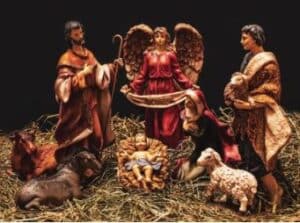Jesus was born in Bethlehem, a small town a few miles from Jerusalem where King David was born (1 Samuel 17:12, etc.) and where the prophet Micah had foretold the Messiah would come (Micah 5:2). Evidence from historical sources, archaeology, and long-standing tradition place the exact location of his birth in a cave just outside the town proper, beneath where the Church of the Nativity now stands.
Jesus’ Birth in Bethlehem
Our primary sources for Jesus’ birth are the gospels of Matthew and Luke. Both place the event in Bethlehem. As Matthew explains:
“Now after Jesus was born in Bethlehem of Judea in the days of Herod the king, magi from the east arrived in Jerusalem, saying, ‘Where is He who has been born King of the Jews? For we saw His star in the east and have come to worship Him,'” (Matthew 2:1-2).
And again:
“Gathering together all the chief priests and scribes of the people, he inquired of them where the Messiah was to be born. They said to him, ‘In Bethlehem of Judea; for this is what has been written by the prophet: “And you, Bethlehem, land of Judah, Are by no means least among the leaders of Judah; For out of you shall come forth a Ruler Who will shepherd My people Israel,”‘” (Matthew 2:4-6).
Some might accuse Matthew of manufacturing Jesus’ birth in Bethlehem simply to have him fulfill this prophecy, but Luke likewise attests to Jesus’ birth in that city without any reference to prophecy:
“Now in those days a decree went out from Caesar Augustus, that a census be taken of all the inhabited earth. This was the first census taken while Quirinius was governor of Syria. And everyone was on his way to register for the census, each to his own city. Joseph also went up from Galilee, from the city of Nazareth, to Judea, to the city of David which is called Bethlehem, because he was of the house and family of David, in order to register along with Mary, who was engaged to him, and was with child. While they were there, the days were completed for her to give birth. And she gave birth to her firstborn son; and she wrapped Him in cloths, and laid Him in a manger, because there was no room for them in the inn,” (Luke 2:1-7).
And again:
“When the angels had gone away from them into heaven, the shepherds began saying to one another, ‘Let us go straight to Bethlehem then, and see this thing that has happened which the Lord has made known to us,'” (Luke 2:15).
No one would seriously suggest that Matthew or Luke were borrowing from one another in their birth narratives, so we have multiple, independent witnesses attesting that Jesus was, indeed, born in Bethlehem.
The cave of tradition
Tradition has long held that Jesus was born in a cave or grotto just outside of town, a place then used as a natural stable for animals and now covered by a church building in honor of the event. Such historical traditions can be later inventions, either due to conscious fraud or an honest mistake by someone who believed they “discovered” the site of some important event. But, as one scholar notes:
“Relying on tradition is less problematic when we have an almost uninterrupted occupation of a site, such as Jerusalem, Bethlehem, or Nazareth”1
“Less problematic” is not the same as fool-proof. In Jerusalem, for example, you sometimes have rival traditional sites both claiming to be the location of the same event. In other cases, it was a later Crusader-era “discovery” of the site that created a tradition long after the event. But if the tradition is unanimous and if the site has been consistently inhabited so that local memory of the location might reasonably have been passed down, such a tradition can be a solid lead for scholars to work with. If archaeological finds are consistent with the tradition and/or it is attested very early in ancient records (especially records by those who lived reasonably close to the site or are at least known to have traveled there), it is likely to be trustworthy.
So, how does the tradition of the Bethlehem cave stack up? As our citation above noted, Bethlehem has been occupied pretty consistently since the time of Jesus. There are also no rival sites, so the tradition warrants our attention. How far back does this idea go?
Historical accounts of the Bethlehem cave
Our earliest mention of the cave tradition is found in Justin Martyr. Writing in the mid-second century AD, Justin tells us:
“But when the Child was born in Bethlehem, since Joseph could not find a lodging in that village, he took up his quarters in a certain cave near the village; and while they were there Mary brought forth the Christ and placed Him in a manger,” (Justin Martyr, Dialogue With Trypho, Chapter 78).
Justin, a gentile convert to Christianity, was a native of Shechem (modern Nablus),2 a city roughly 36 miles from Bethlehem as the crow flies. That is not super close, but in Justin’s day both towns would have been part of the same Roman province of Palestine, and so this is a better source than if it was written by someone in, say, Rome or Ephesus who had no connection to the people and culture of the land where Jesus was born. When it comes to ancient history, 150 years after the event and only 36 miles removed is a pretty close source. Still, if we want to corroborate this tradition with any certainty, it would help to have additional early sources.
Fortunately, we do. Our next earliest is Origen of Alexandria. Origen lived during the latter half of the second century on through the first half of the third. Though he spent much of his life in Alexandria, Egypt, Origen also traveled in and later relocated to the Judean city of Caesarea Maritima. He wrote:
“With respect to the birth of Jesus in Bethlehem, if anyone desires, after the prophecy of Micah and after the history recorded in the Gospels by the disciples of Jesus, to have additional evidence from other sources, let him know that, in conformity with the narrative in the Gospel regarding His birth, there is shown at Bethlehem the cave where He was born, and the manger in the cave where He was wrapped in swaddling-clothes. And this sight is greatly talked of in surrounding places, even among the enemies of the faith, it being said that in this cave was born that Jesus who is worshipped and reverenced by the Christians.” (Origen, Against Celsus, Book 1, Chapter 51)
Here, we not only have affirmation of the cave tradition but we are further informed that the site was well known at the time and contained a manger which was then believed to be the one in which Jesus’ was laid. Origen writes as one acquainted with the site. He may well have traveled there himself while living in Judea, or (living, as he was, in the region’s major port town) he may have met travelers who had visited the site. At any rate, Origen provides an additional early record that such a site existed and its location was well known to Bethlehem locals at the time.
Another much weaker witness from this time period is the highly apocryphal and non-historical “Protoevangelium of James”. This fictional work of quasi-gnostic (or, at the very least, docetic) literature retells the story of Jesus’ birth, borrowing heavily on the biblical gospels but adding numerous imaginative details (such as Jesus miraculously exiting Mary’s womb in a flash of light so that she remains in the clear physical state of her virginity, nothing having passed through). This book, written sometime in the late second or early third century, assumes the tradition of Jesus’ birth in a cave outside of town near Bethlehem3 This is obviously not the kind of source one should look to for historical data, but when combined with our other sources, it does show that the idea of Jesus being born in such a cave was widespread both within and outside the orthodox Christian faith. As Origen noted, the site was obviously talked about “even among the enemies of the faith.”
As we move on to the fourth century, the historian Eusebius of Caesarea notes that Helena, the Christian mother of Emperor Constantine, funded the construction of a church building at this site:
“For without delay she dedicated two churches to the God whom she adored, one at the grotto which had been the scene of the Saviour’s birth; the other on the mount of his ascension. For he who was ‘God with us’ had submitted to be born even in a cave of the earth, and the place of his nativity was called Bethlehem by the Hebrews. Accordingly the pious empress honored with rare memorials the scene of her travail who bore this heavenly child, and beautified the sacred cave with all possible splendor. The emperor himself soon after testified his reverence for the spot by princely offerings, and added to his mother’s magnificence by costly presents of silver and gold, and embroidered hangings,” Eusebius of Caesarea, The Life of Constantine, Chapter 43
Another fourth-century historian, Socrates Scholasticus, likewise reports in his Ecclesiastical History that Helena built a church “over the cave at Bethlehem where Christ was born”4 but as he lived more distantly in Constantinople and personally knew of Eusebius’ work, his testimony may be little more than an echo what he read in Eusebius.
Jerome, the fourth-century Christian scholar most famous for his role in the translation of the Latin Vulgate, spent the latter part of his life in Bethlehem (having moved to Palestine to learn Hebrew for his translation work). He frequently mentions the cave in his letters, calling it “the cave wherein the Son of God was born,”5 “that venerable cave,”6 “the cave of His birth,”7 “the cave of the savior,”8 and “the very cave where the infant Christ had uttered His earliest cry.”9 He writes of it:
“Behold, in this poor crevice of the earth the Creator of the heavens was born; here He was wrapped in swaddling clothes; here He was seen by the shepherds,” (Jerome, Letter to Marcella, Section 11)10
Within the cave, he speaks of a place that “is now the altar, as it was once the manger, of the Lord.”11 While he could just be using flowery language, it is very possible that the altar was specifically placed where the manger mentioned by Origen once sat. This further lends itself to the continuity between these locations. Jerome also mentions as an apparently known location “the place where the shepherds were watching their flocks when they heard the angels singing overhead.”12
Thus, there are numerous sources from the second through the fourth centuries that show:
- An early belief that Jesus was born in a cave just outside of town in Bethlehem.
- That this cave was in a location well-known to the locals and those in the surrounding region.
- That a church was eventually established on that very site.
Some of these witnesses are admittedly weak while others are much stronger, but taken together as a whole, they point to a very early, consistent, and plausible tradition.
The archeological evidence
Archaeology is limited in what it can tell us about this particular event. We cannot dig up the birth of Jesus. All the people involved in the events surrounding Jesus’ birth went on to do other things and presumably took their possessions with them. There would be nothing left to unearth. Still, there are a couple of ways that archaeology can help us.
First of all, when we look at the caves under the current Church of the Nativity, do we find evidence that they were being used at that time? After all, if people weren’t utilizing these caves to stable their animals, then they can’t possibly be where Jesus was born. The fact of the matter is, however, that these caves were, indeed, in human use at the proper time.13 That doesn’t prove that Jesus was born here, but it does mean that it is possible.
Secondly, archaeology shows us that the site where the Church of the Nativity is standing today is the same site as the original church built in the fourth century.14 This means that the traditional site of today is the same site that goes back at least to the time of Eusebius and Jerome in the fourth century and thus almost certainly back to Origen’s time in the early third century. It is no large leap to then say that this is the cave Justin mentioned in the second century, which means that locals have consistently held this (and, best we can tell, only this) site to be the location of Jesus’ birth for almost 2,000 years.
Conclusion
Jesus was certainly born in Bethlehem. The arrival of the shepherds that night telling of angelic messengers and the birth of this child, followed by the later visit of the eastern Magi seeking to worship him and the violent attack by King Herod would have plausibly left a significant mark on this small community. This could well have led locals to remember and pass on where it had happened. We have a very ancient tradition, reinforced by historical and archaeological data, that tells us of locals identifying a specific cave just outside of town as the place where Jesus was born, and the site of this cave is now marked by a church building (and has been since the fourth century). While it is certainly possible that this tradition is just local lore that developed very early on and managed to persist long enough for Christians to formally embrace it, it seems highly probable that this really is the location of Jesus’ birth.
References
| 1↑ | Richard A. Freund, Digging Through the Bible (Rowman & Littlefield Publishers, 2009) 32 |
|---|---|
| 2↑, 14↑ | Randall Price, Zondervan Handbook of Biblical Archaeology (Zondervan, 2017) 235 |
| 3↑ | Protoevangelium of James, Chapter 18 |
| 4↑ | Socrates Scholasticus, Ecclesiastical History, Book 1, Chapter 17 https://ccel.org/ccel/schaff/npnf202/npnf202.ii.iv.xvii.html (Accessed 11/11/2021) |
| 5↑ | Letter to Sabinianus, Section 4 (Letter CXLVII in ANF, https://ccel.org/ccel/schaff/npnf206/npnf206.v.CXLVII.html) |
| 6↑, 12↑ | Ibid, Section 6 |
| 7↑ | Ibid |
| 8↑ | Letter to Marcella, Section 11 (Letter XLVI in ANF https://ccel.org/ccel/schaff/npnf206/npnf206.v.XLVI.html) |
| 9↑ | Letter to Paulinus, Section 3 (Letter LVIII in ANF https://ccel.org/ccel/schaff/npnf206/npnf206.v.LVIII.html) |
| 10↑ | Letter XLVI in ANF https://ccel.org/ccel/schaff/npnf206/npnf206.v.XLVI.html |
| 11↑ | Letter to Sabinianus, Section 5 (Letter CXLVII in ANF, https://ccel.org/ccel/schaff/npnf206/npnf206.v.CXLVII.html) |
| 13↑ | Joel Cramer, Where God Came Down: The Archaeological Evidence (Expedition Bible, 2020) 93 |






